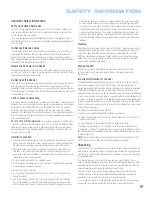
15
INTRODUCTION TO HOME THEATER
The HS 300 may be the first multichannel surround sound component
you’ve owned. This introductory section will help you to familiarize yourself
with the basic concepts, which make setup and operation smoother.
If you are already familiar with home theater, you may skip this section
and proceed to the Connections section on page 16.
Typical Home Theater System
A home theater typically includes your audio/video receiver, which controls
the system; a DVD player; a source component (e.g., a cable box, a
satellite dish receiver, an HDTV tuner or simply an antenna connected to
the TV) for television broadcasts; a video display (TV); and loudspeakers.
The HS 300 offers a simpler solution by integrating the DVD player with
the receiver, resulting in a sleek, streamlined component with just a few
connections needed to enjoy a complete home theater experience.
All of these components are connected by various types of cables for
audio and video signals.
Multichannel Audio
The benefit of a home theater system is that several loudspeakers are
used in various locations around the room to produce “surround sound,”
immersing you in the musical or film presentation for increased realism.
The HS 300 may have up to five speakers connected to it (plus a
subwoofer). Each speaker is powered by its own amplifier channel,
and the subwoofer has its own amplifier on board.
•
Front Left and Right –
The main speakers are used the same way
as in a two-channel system. However, you may notice that in many
surround modes, these speakers are used more for ambient sound
while the main action and dialogue are moved to the center speaker.
•
Center –
The center speaker is usually placed above or below the
video screen, and is used mostly for dialogue in movies and television
programs. This placement allows the dialogue to originate near the
actors’ faces, for a more natural sound.
•
Surround Left and Right –
The surround speakers are used to
improve directionality of ambient sounds. In addition, by using more
loudspeakers in the system, more dynamic soundtracks may be
played without risk of overloading any one speaker.
Many people expect the surround speakers to play as loudly as the
front speakers. Although all of the speakers in the system will be
calibrated to sound equally loud at the listening position, most sound
tracks use the surround speaker for ambient effects only, and they
program their materials to steer very little sound to these speakers.
•
Subwoofer –
A subwoofer is a special-purpose speaker designed
to play only the lowest frequencies (bass). It is used to augment the
smaller, limited-range satellite speakers used for the other channels.
In addition, many digital-format programs, such as movies recorded
in Dolby Digital, contain a special low-frequency effects (LFE) channel
that is directed only to the subwoofer. The LFE channel packs the
punch of a rumbling train or airplane, or the power of an explosion,
adding realism and excitement to your home theater.
Surround Modes
There are different theories as to the best way to present surround
sound and to distribute soundtrack information among the various
speakers. A variety of algorithms have been developed in an effort to
accurately reproduce the way we hear sounds in the real world. The
result is a rich variety of surround mode options. Some modes are
selected automatically, depending on the signal being received from
the source. In many cases, you may select a surround mode manually.
Several companies have taken surround sound in slightly different
directions. It is helpful to group the numerous surround modes either
by their brand name, or by using a generic name:
•
Dolby Laboratories, Inc., Modes:
Í
Dolby Digital –
This mode is encoded in the program material
either on a disc or within a television broadcast. It provides up to
five separate main audio channels and a dedicated low-frequency
effects (LFE) channel.
Í
Dolby Pro Logic II –
This mode is derived by an analog decoder
built into the HS 300 that derives five full-range, discrete main
audio channels from matrix surround-encoded or 2-channel analog
sources. Select from Dolby Pro Logic II Movie, which is optimized
for movies and television programs; Dolby Pro Logic II Music,
which is optimized for music selections; or Dolby Pro Logic, the
original version that steered a mono signal containing information
below 7kHz to the surround channels.
•
DTS Mode –
DTS is a digital surround format that is encoded in the
program material. It uses a different encoding and decoding method
than Dolby Digital to provide up to 5 discrete main channels, plus an
LFE channel. The HS 300 is capable of playing DTS materials when
the Original setting is selected for the audio mode.
•
Stereo Mode –
Two-channel mode with no surround sound.
These surround modes may be selected on the HS 300 using the DVD
Sound Mode setting found in the Audio Setup submenu (for the Disc
Player), or the Audio Mode Setting within the on-screen menu for each
source. For digital audio sources, such as the internal disc player or any
source using one of the digital audio inputs, select Original to benefit
from any digital surround modes encoded in the source materials.
Digital modes, such as Dolby Digital and DTS, are only available with
specially encoded programs, such as DVDs and digital cable or satellite
television. Other modes may be used with various digital and analog
signals to create a different surround presentation, or to use a different
number of speakers. Surround mode selection depends upon the
number of speakers in your system, the materials you are watching
or listening to, and your personal tastes. Feel free to experiment.
Содержание HS 300
Страница 1: ...HS 300 INTEGRATED HOME THEATER SYSTEM OWNER S MANUAL...
Страница 4: ...4 STAPLE INVOICE HERE...
Страница 78: ...78 NOTES...
Страница 79: ...79 NOTES...
















































